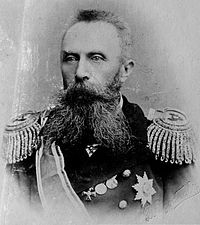- Oskar Victorovich Stark
-
Oskar Victorovich Stark 
Oskar Victorovich StarkNickname (Russian: Оскар Викторович Старк Born August 16, 1846 Died November 12, 1928 (aged 82)
Helsinki, FinlandAllegiance 
Service/branch Imperial Russian Navy Rank Admiral Battles/wars Russo-Turkish War (1877-1878)
Russo-Japanese War
World War I
Russian Civil WarAwards  Order of St Vladimir, 2nd degree
Order of St Vladimir, 2nd degreeOskar Victorovich Stark (Russian: Оскар Викторович Старк, 16 August 1846 — 13 November 1928) was a vice-admiral in the Imperial Russian Navy and a noted explorer of Peter the Great Bay and the Far Eastern seas. A strait in Peter the Great Bay and a bay in the Tatar Strait are named after him.
Biography
Stark graduated from the Sea Cadet Corps in 1864. In his early career, he participated on numerous expeditions as commander of the frigate Vostok from 1874-1977 to chart the Arctic and Pacific coasts of Siberia. He subsequently captained a gunboat in the Russo-Turkish War (1877-1878) and later the gunboats Sivuch and Pervenets. He was captain of the cruiser Vladimir Monomakh from 1891-1892. From 11 April 1898 to 7 October 1902 Stark served in the Russian Pacific Fleet. On 6 December 1902, he was promoted to vice admiral. By appointment from Viceroy of the Far East Yevgeni Ivanovich Alekseyev, Stark was commander of the Russian naval base at Port Arthur from 1 May 1898 to 7 October 1902. On 7 February 1902 he concurrently held the position of Commander of the Russian Pacific Fleet.
At the start of the Russian-Japanese War, the Imperial Japanese Navy launched a pre-emptive strike on the Russian fleet anchored at Port Arthur. At the time of the attack, Stark was holding a birthday party for his wife on the deck of his main battleship, the Petropavlovsk, and the crowd attending the party mistakenly thought the exploding Japanese ordnance was fired in honour of the birthday. Here is a quote from commentary on the beginning of the battle:
“ The band was playing loudly, and the most honorary guest, Admiral Alekseyev, the viceroy, glided along the parquet with the heroine of the day with surprising grace for his rather obese figure. When the dance reached its apogee, and the viceroy stood on his knee to circle the lady, the windowpanes suddenly shook from the thunder of the cannonade. Everyone applauded surprised by such a timely salute, and the overall excitement increased. The ball continued to the accompaniment of the orchestra and artillery fire. ” The Japanese attack less-than-entirely successful, and Stark (despite wanting to engage the Japanese and being over-ruled by the viceroy) was loudly criticized in the Russian and the world press as having suffered a huge defeat, and was subsequently sacked by Tsar Nicholas II from his post on 24 February 1904. Vice Admiral Stepan Makarov arrived on 8 March 1904 as his replacement. Stark was given the Order of St. Vladimir and recalled to a staff assignment with the Russian Black Sea Fleet, and continued to be regarded ss a scapegoat for the Battle of Port Arthur.
After the war, Stark was discharged from the military in 1908 and became involved in business activities. For a time he was Chairman of the Board of the Obukhov State Plant and the Izhorskiye Zavody.
With the start of World War I, Stark was recalled to duty. He was sent to Vladivostok to take command of the Russian Siberian Squadron, the battered remnants of the Russian Pacific Fleet. Although he was able to keep the port open, vital military stores accumulated on the docks due to the small number of trains on the Trans-Siberian Railway and the brutal Siberian winter. After the Russian Revolution, Allied forces occupied Vladivostok as part of the Siberian Intervention to precent these war materials from falling into Bolshevik hands. Stark became part of the White movement and remained at Vladivostok throughout the Russian Civil War. With the victory of the Bolshevik Red Army imminent by October 1922, Stark mustered the 30 barely working ships of the Siberian Squadron and organized an evacuation of Vladivostok of more than 9,000 people to Wonsan in Korea. Eighteen ships and three fourths of the refugees remained in Korea under the care of the Japanese Red Cross as their ships had either broken down or did not have enough fuel to continue. The remainder of the fleet moved on through a typhoon in which the destroyer Dydymov and the transport Asia were lost with all hands. Stark arrived in Shanghai with only ten ships and 3,000 refugees. However, the Chinese government ordered his stateless navy and its unwelcome refugees to depart Chinese waters in 48 hours or be attacked. Stark disembarked all of his non-naval personnel including former White Army General Mikhail Dieterichs and the civilians in Shanghai and proceeded to Manila Bay where he sold the last of his pitiful fleet at auction to help support the refugees. He ordered the flag of Imperial Russia lowered for the last time in the Pacific on January 15, 1923.
Stark subsequently went into exile at Helsinki, Finland, where he died in 1928.
References
- Connaughton, R.M (1988). The War of the Rising Sun and the Tumbling Bear—A Military History of the Russo-Japanese War 1904–5, London, ISBN 0-415-00906-5.
- Jukes, Geoffry. The Russo-Japanese War 1904–1905. Osprey Essential Histories. (2002). ISBN 978-1-84176-446-7.
- Warner, Denis & Peggy. The Tide at Sunrise, A History of the Russo-Japanese War 1904–1905. (1975). ISBN 0-7146-5256-3.
Categories:- 1846 births
- 1928 deaths
- Russian explorers
- Imperial Russian Navy admirals
- Russian and Soviet polar explorers
- Russian military personnel of the Russo-Japanese War
- Recipients of the Order of St. Vladimir, 2nd class
Wikimedia Foundation. 2010.
